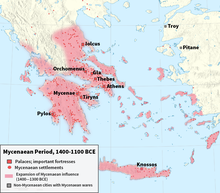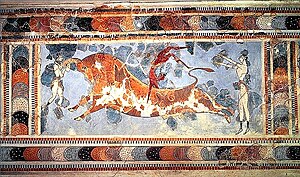Wikijunior:Ancient Civilizations/Mycenaeans
Where did they live?
[edit | edit source]
The Mycenaeans lived in mainland Greece from approximately 1600–1100 B.C. They were the first advanced civilization in mainland Greece. They are sometimes called the first Greeks because they were the first to speak the Greek language. Their largest city was called Mycenae, which gives the culture its name. Mycenae was a large city that had a population of around 30,000 people at its peak. There were other Mycenaean cities that grew into major city-states during the height of Ancient Greece such as Thebes and Athens.
The Mycenaeans developed trade throughout the Mediterranean. They built large trade ships and traveled to places like Egypt where they traded goods like olive oil and wine for metals and ivory.
They were considered a warrior people. Expansion (growing their country) was very important to them. They were the downfall of other, less powerful cultures, including the Minoans. The famous city of Troy also fell to their army and naval strength.
What did their buildings look like?
[edit | edit source]


In the eyes of the later Greeks, the Mycenaeans were larger than life. One reason for this belief comes from the ruins of the Mycenaean city-states. The walls around these palaces are massive, made from blocks of stone weighing several tons and carried to the mountain-top settlements. The later Greeks called these walls cyclopean walls, named after the one-eyed giant race, because the later Greeks felt only giants could move the stones.
A walled mountain or hilltop settlement is called a citadel. Carefully built on fertile plains, at ports or near the coastline, the citadel was the center of power and authority. The palace was placed at the top of the structure. The complex was not just a military one. It had many functions, including worship and storage, with areas for each purpose.
What did they wear?
[edit | edit source]

The Mycenaeans inherited some of the clothing styles of the Minoan civilization, a civilization on the island of Crete whom they probably conquered. One of these styles was women's pairing of long skirts, typically with colorful geometric patterns, gold sequins, and bolero shirts (like a small jacket) with an open front. The Mycenaeans adopted most of this, but often changed the open-fronted shirt and closed it or covered it with another shirt.
Men wore loin cloths which were pieces of cloth tied around the waist to cover the groin area. The most common clothing for men was a tunic. Tunics in the Mycenaean civilization were usually long dress-like shirts with long sleeves and were typically tied around the waist with a belt. Soldiers usually wore an armor of bronze.
Jewellery was a important part of a Mycenaean woman’s daily outfit. Their jewellery varied from necklaces and bracelets to anklets, brooches, and diadems. Based on what has been found in graves, women wore very impressive jewellery that gave a strong insight to her social class. Dark blue was especially desirable, because it was a very rare and expensive stone.
What did they eat?
[edit | edit source]We do not know a lot about food in the Mycenaean civilization, except from trade. From trade records, we know that the Mycenaeans were major producers of olive oil, wine, and grains. We also know that they hunted, based on what we know about their sports. The average Mycenaean diet was probably composed of various grains and some kind of meat - probably deer or boar.
What did they believe?
[edit | edit source]The Mycenean religion was very similar to that of the Minoans'. The Minoan "Earthshaker", became known as Poseidon. The Goddess became known as Athena, Hera, Rhea, Demeter, and Artemis. Minoan symbols are found throughout Mycenea and include the bulls, pillars, doves, and snakes.
Not much is known about the religious practices of the Mycenaeans. They worshipped many gods, but only a few names of their many gods have appeared in tablets uncovered in archeological digs. Almost no temples or central places of worship have been discovered.
The Myceneans practiced human sacrifice.